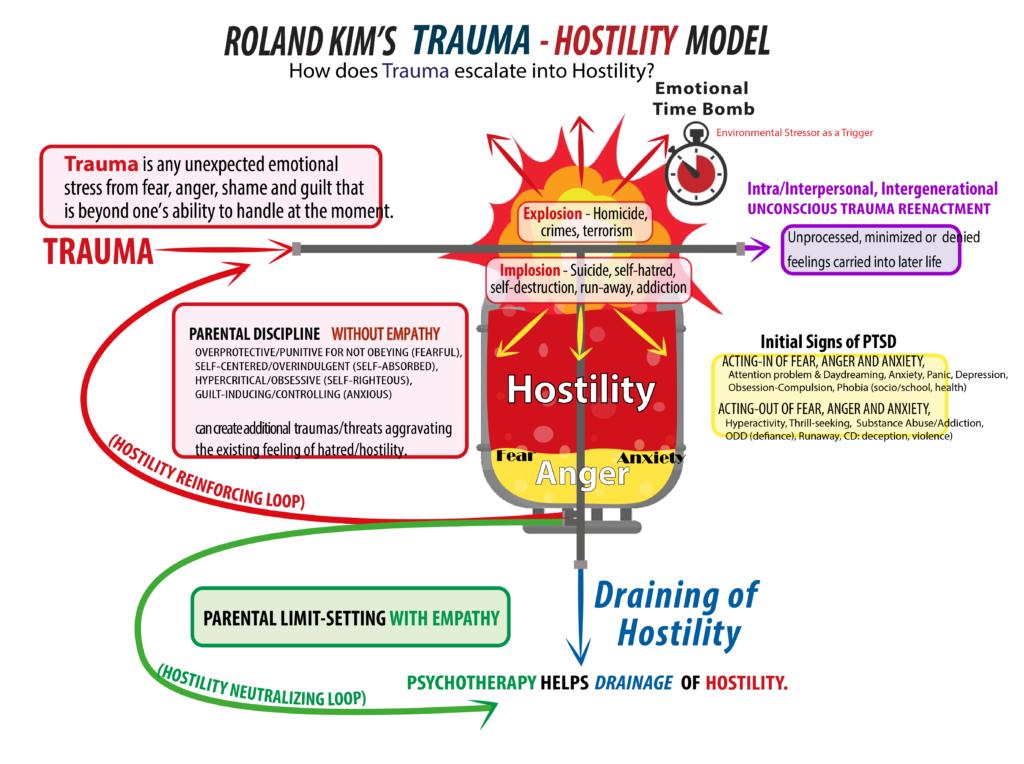How important is it to process the trauma experienced? Well-intentioned people as trauma survivors often reenact similar traumas on themselves or others, including their own siblings or children, due to the improper processing of their own traumas; therefore, the survivors’ ability to break the cycle of intrapersonal, interpersonal, and intergenerational transmission of trauma may depend on how the survivors timely handle the impact of the trauma.
Though Freud used drive-reduction as the motive, Kim’s (2021A) proposed model follows the psychodynamic approach with the modification of the frustration-aggression model to the Trauma-Hostility model (Glick, 2002; Allport, 1954/1979).

*This Figure was originally introduced in Roland Kim’s The Five Stages of Civilization (2021a, p. 160).
The Trauma-Hostility diagram shows how unprocessed feelings of fear, anger, and anxiety/guilt from trauma can be escalated and even transmitted to the self, others, and the next generation in various ways depending on the survivor’s emotional state. The unpressed, repressed, or denied feelings of trauma experienced by the first trauma survivor can manifest again through the unconscious reenactment of a similar traumatic situation. For example, the traumatic situation experienced through a natural disaster, premature separation/abandonment from parents, harsh punishment, or violence witnessed can be unconsciously reenacted through the choice of a profession (e.g., paramedic or military), a partner (e.g., an alcoholic), or victimizing one’s own child at a similar age when the survivor experienced the trauma. This intrapersonal, interpersonal, and intergenerational reenactment of trauma is believed to be motivated by the unconscious need for mastery, retribution, compensation, or atonement, depending on the arrested emotional stage of the trauma survivor. The hypothetical Unconscious Trauma Reenactment (UTR) process (Kim, 2021A) may follow the phases through a defense mechanism of splitting and projective identification (PI) as primitive psychological defense mechanisms first introduced by Klein (1946, 1955). PI happens when survivors separate the intolerable, unbearable part of their own emotions such as fear, anger, or hostility from trauma to place onto targeted others identified as the projectors themselves. In other words, the projection or externalization of hostility (e.g., homicide) can be preceded by the identification or internalization of hostility (e.g., suicide) in Stage 1, while the externalization can only occur in Stage 2.
Applying Ogden’s (1979; 1993) three phases of the PI process in psychotherapy and Kim’s (2021A) proposed 5-Stage Trauma-Hostility Model, the following phases of UTR can similarly be deduced:
Phase 1 (Motive): After being affected by trauma, the survivor, without neutralizing its impact, tries to get rid of the unwanted part of the self (panic, fear of survival, vengeance, or violence at Stage 1, denied anger and hostility at Stage 2, and suppressed anxiety/guilt at Stage 3).
Phase 2 (Target Search): Though the projector at Stage 3 may search for the target survivor from a distant out-group, the projective identification at Stage 1 or Stage 2 may unconsciously search for someone with who the projector can feel familiar and comfortable based on certain shared familial, cultural (i.e., minority) or environmental (i.e., workplace, school) backgrounds. For example, Hitler may have targeted the Jews for his PI of hostility through genocide because the Jews were a model minority, and they shared the same genetic root with him as half Jewish blood through his mother. After identifying a targeted person, group, or population through PI, the survivor induces the unprocessed negative emotions projected onto them through PI.
Phase 3 (Reinternalization) by checking the congruence of the targeted trauma recipient’s emotional reaction to the projector’s original emotional pain from trauma: The targeted person, group, or population, conscious or unconscious, or voluntary or involuntary, becomes the sacrificial scapegoat as the recipient of the projector’s unconscious, unwanted parts of self, such as fear, vengeance, violence, anger, hostility, and anxiety. The projector learns the actual or imagined consequences of the projective action on the target. The target will be a helpless and vulnerable scapegoat of the projector’s projection, and unless the UTR cycle is broken through the timely processing of the trauma, the targeted survivor subsequently becomes an unintentional reenactor of trauma, either through internalization or externalization, allowing a similar trauma to happen through the unconscious process of PI on the next target.
Table 1: Unconscious Trauma Reenactment (UTR) from the 5-Stage perspective
| Stage 1 | Stage 2 | Stage 3 | Stage 4 | Stage 5 | |
| The initial trauma survivor’s emotional state | Repressed fear, panic, vengeance | Denial of repressed anger and hostility | Anxiety and guilt | Emotional freedom | |
| Projector’s typical behavior toward others’ pain | PI: “Your pain is all your fault as much as my pain was my fault, ” “You deserve the pain,” “You are not the only one in pain; I was in pain too.” | Rationalization: “The pain was not that bad.” “You can endure it as I did.” | Internalization with guilt: “Don’t talk about it because it is too painful to hear. I feel too guilty.” | Acceptance of the blindness and grieving together through sharing the emotions. | |
| Defense Mechanism | Intrapersonal Projective identification making the survivor feel the very fear, panic, and vengeance that the original survivor subjectively experienced | Intrapersonal Displacement of repressed anger and hostility through Projective identification | Interpersonal Introjective identification guilt and anxiety-inducing the survivor to experience | ||
| A typical cycle of trauma | Unconscious reenactment of physical or sexual abuse; abandonment through unconscious identification of fear, panic, punishment, vengeance toward intimate others or outgroup | Reenactment of the victimization such as scapegoating through rationalization and denial of anger and hostility | Subconscious reenactment of a similar situation inducing guilt and anxiety | Conscious creation of a situation with objectivity and emotional freedom | Conscious creation of any challenging situation with empathy |
| Typical maladaptive behaviors | Homicide, terrorism, hate crime; suicide, self-harm; addiction to substances and intoxication | Diversion to other addictive activities; substance (ecstasy) | Isolation and avoidance (hikikomori); substance use for relief of anxiety or sleep aid |
Table 2: Patterns and examples of Unconscious Trauma Reenactment (UTR)
| Unconscious trauma patterns | Examples of Unconscious Trauma Reenactment |
| Unconscious Intrapersonal re-creation of trauma | Committing non-suicidal self-harm, sabotaging a life of success and progress, suicide including suicide-bombing and murder-suicide, Choosing or volunteering for self-destructive action or activities (addiction or abuse of dangerous substances), high-risk action (possessing deadly weapons such as knives and guns), high-risk occupation, high-risk relationship (dating a gang member, a drug addict, or an alcoholic, or an unavailable partner), thrill-seeking hobbies or activities (driving a motorcycle, watching crime stories, war stories, or forensic files) |
| Unconscious Interpersonal reenactment of trauma | Showing anger-outburst or explosion, committing violence, homicide, terrorism, inflicting various harms and damages on others to feel fear, terror, panic, anger, or anxiety the survivor experienced |
| Unconscious Intergenerational reenactment of trauma | Allowing the next generation to be exposed to similar traumas at a similar age when the first-generation survivor experienced them (i.e., child maltreatment including physical and sexual abuse, physical and emotional neglect, premature separation, abandonment, or sexual abuse) |
Then, is it possible to apply a similar explanation to the context and prevention of terrorism, which often takes the form of suicide and homicide? Kim’s proposed 5-Stage and Trauma-Hostility Model can be applied to explore the possible origin of terrorism across various social contexts.
Figure 1 illustrates how children’s normal anger and aggression escalate into hostility when they are denied empathic feedback from their parents or environment, such as the society they belong to. The diagram shows how escalated hatred and hostility can manifest through either explosion (destructive behaviors toward others) or implosion (self-destruction) in their most extreme forms.
Therefore, terrorism can be understood as the culmination of the emotional and socio-cultural injury from earlier trauma, abuse, or brainwashing that has not been neutralized or processed by the parents’ or social environment’s timely intervention through empathy. The fact that setting limits on children’s aggressive and hostile behaviors may be perceived by the trauma survivors as hurtful and harmful represents a salient parenting challenge (Parens, 2006) when dealing with an emotionally injured child or potential terrorists. The Trauma-Hostility Model highlights that any limit-setting must first be preceded by empathy, i.e., emotional understanding. To de-escalate the children’s sense of rejection, persecutory fear, and escalated hostility, parents must use empathy as a primary measure and let natural consequences or law teach them the limit of their unacceptable behaviors. Punishments based on logical consequences or an impromptu decision made by any parents or authorities can be perceived as intentional harm reminding them of their original injury or trauma they may perceive as intentionally inflicted due to their immature emotional state. The emotionally injured children may perceive any good-intentioned punishment or consequences as devoid of unconditional acceptance or empathic responses that they may have been secretly seeking to heal from the original emotional injury from the trauma.
Interestingly, many terrorists who carried out their acts had been detected under the national security radar. This suggests that escalation of the hostility had been overlooked during the incubation period before the final acts of terror while they were under the police radar. Therefore, more effective prevention of terrorism may deter potential home-grown terrorism through effective domestic policy based on active hostility-neutralizing education and therapy, rather than passive monitoring, watch-listing, and screening for potential terrorists. It may also take more inclusive international policy measures to help countries representing hotspots for terrorism to adopt a less hostile attitude, the origins of which may be historical and intergenerational.
It is also possible to apply the parallel analysis by Lachkar of those “unresolved archaic injuries or V-spot (vulnerable spot)” with terrorism (2006, par 9; 2007) along with the concept of PI to understand how people with childhood trauma, typically through abandonment or neglect, turn into terrorists once they perceive any sign of rejection, abandonment, or necessary limit-settings by the target as persecutory. Lachkar’s analysis drawing on individual pathology of borderline personality disorder behind terrorism seems insightful and convincing in understanding the origins of terrorism against the chosen people, the Jews motivated by the Arabs as neglected and abandoned people, though it may need more research to be used to find the motivation of group terrorism.
The Trauma-Hostility Model, along with the Unconscious Trauma Reenactment (UTR) model, is a convenient tool for understanding and assessing the danger of unneutralized trauma to survivors and society. For various psychological reasons, we learn through theorists such as Klein(1946; 1955), Bion (1962), and Parens (2006) that the empathic and reparatory approach is more effective than the conventional punitive (authoritarian parenting) or disciplinary approach (authoritative parenting with consequences) to help these untreated trauma survivors.
References
Allport, G. W. (1954/1979). The nature of prejudice. Cambridge, MA: Perseus Books.
Bion, A. (1962). Learning from experience, London: Heinemann.
Glick, P. (2002). Sacrificial lambs dressed in wolves’ clothing: Envious prejudice, ideology, and the scapegoating of Jews. In L. S. Newman & R. Erber (Eds.), Understanding genocide: The social psychology of the Holocaust (pp. 113–142). Oxford University Press. https://doi.org/10.1093/acprof:oso/9780195133622.003.0006
Kernberg, O. F. (1987). Projection and projective identification: Developmental and clinical aspects. Journal of the American Psychoanalytic Association, 35(4), 795-819. https://doi.org/10.1177/000306518703500401
Kim, R. (2021a). The Five Stages of Civilization: From an Integrated Psychological and Psychoanalytic Perspective, Vol. 1 Personality Development. Living Free Publishing Co.
Klein, M. (1946). Notes on some schizoid mechanisms. In Envy and Gratitude and Other Works: 1946-1963. Virago Press Limited 1988, pp. 1-24.
Klein, M. (1955). On identification. In Envy and Gratitude and Other Works: 1946- 1963. Virago Press Limited 1988, pp. 141-175.
Lachkar, J. (2006). The psychopathology of terrorism: A cultural V spot. Journal of Psychohistory, 34(2), 111-128. http://primal-page.com/lachkar.htm
Lachkar, J. (2007). The V-Spot: Healing the vulnerable spot from emotional abuse. Jason Aronson.
Ogden, T. (1979). On projective identification. International Journal of Psychoanalysis, 60: 357-373.
Ogden, T. (1993). Projective identification and psychotherapeutic technique. Jason Aronson Inc.
Parens, H. (1979). The development of aggression in early childhood. Jason Aronson.
Parens, H. (2006). Why boundaries, fences, and walls around the self? A concluding commentary. In S. Akhtar (Ed.), Interpersonal boundaries: Variations and violations (pp. 99-112). Jason Aronson.








